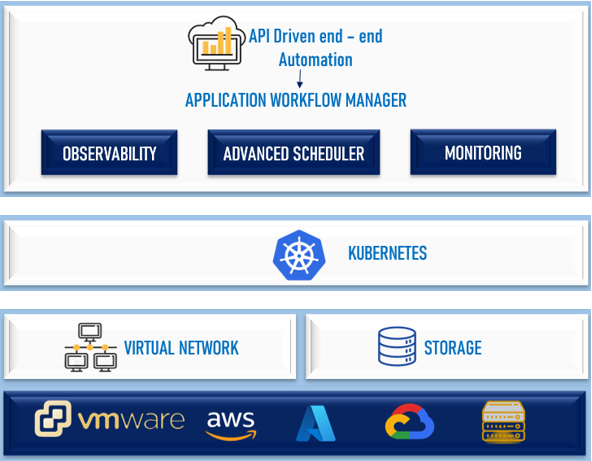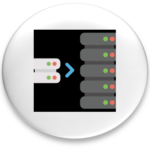Symcloud CNP
An Enterprise Kubernetes Platform
Symcloud Platform (formerly known as Rakuten’s Robin CNP – Robin Cloud Native Platform) is an enhanced Kubernetes platform that streamlines the deployment, scaling, and lifecycle management of data and network-intensive applications. It leverages the power of Kubernetes, offering a comprehensive solution that includes automated installation, lifecycle management, upgrades, monitoring and much more.
In this blog, the below topics will be covered:
- What is Kubernetes?
- Why Kubernetes needs enhancements?
- Other Kubernetes offerings
- Symcloud Platform Overview
- Symcloud Platform Architecture and Features
- Symcloud Platform features compared to other Kubernetes offerings
- Summary
What is Kubernetes
Kubernetes, maintained by the Cloud Native Computing Foundation (CNCF), is an open-source container orchestration solution that automates the deployment, scaling and lifecycle management of containerized applications across clusters of nodes. Containers are used to isolate application components into lightweight software packages that encapsulate applications as well as their dependencies, providing consistent and efficient deployment across different cloud environments and locations including public, private, and hybrid clouds and bare metal.
With Kubernetes, you can define and manage application resources: compute, storage, and networking, using a declarative configuration that describes outcomes, rather than all of the steps required to perform those outcomes. Additionally, Kubernetes provides a suite of capabilities for service discovery, load balancing, and self-healing, ensuring high availability and fault tolerance. This enables applications to run consistently and efficiently by automatically distributing workloads, monitoring health, and scaling resources based on demand.
Kubernetes has replaced Virtual Machines (VM) solutions as the architecture of choice by providing superior performance, resource efficiency, scalability, application isolation, security and it also provides a better solution for running both containers and VMs, compared to legacy solutions.

Why Kubernetes needs Enhancements
While Kubernetes is a powerful container orchestration platform, vanilla Kubernetes has certain limitations. Let us breakdown and understand various limitations in more detail:
- Complex Coding Architecture: Kubernetes is a complex system; learning how to use it properly can take significant time and requires in-depth knowledge of other core technologies like OS’s, networking, storage, application requirements etc. Furthermore, it is plagued with a tedious Command Line Interface that imposes yet another learning curve that can challenge small teams or developers with limited experience, and can become a scripting nightmare. Most of the popular Kubernetes distributions have shown zero advancements on this front, where they lack usable GUI for core features and require manual hunting and hardcoding for the right resource, on the right rack, on the right node, at the right location.
- Tedious Cluster Upgrade Process: Kubernetes is changing rapidly and demands an upgraded environment to get community support. The manual upgrade process for Kubernetes can be very cumbersome and time consuming.
- Lack of Stateful Storage Automation Support: Kubernetes was designed with ephemeral stateless applications in mind, but has limited functionality supporting those high revenue generating persistent/stateful applications such as databases, analytics, SmartX, messaging services, security and network services. Kubernetes only offers a primitive Container Storage Interface (CSI) with limited automation for stateful, persistent, storage capabilities. This limitation then requires third party container storage solutions to run stateful applications managed by Kubernetes, which further extends the learning curve and complexity.
- Network Flexibility: Networking can be complex, especially for applications with multiple services and dependencies found in telcos and hosted enterprise services. It requires meticulous configuration and management to ensure all services are accessible and operational. By default, Kubernetes does not ship with a networking solution, requiring one to identify and integrate container network add-ons. To keep up with today’s cloud networking trends, a Network-as-a-Service model must be added.
- Visibility issues: Monitoring traffic across multiple hosts in a K8s cluster can be challenging, particularly in diverse, multi-tenant, environments. However, integrating monitoring of third-party applications can enhance visibility within your environment.
- Edge Optimization: Kubernetes was initially built to ramp up to a massive web scale. Therefore, most solutions were not optimized for footprint utilization and suffer from immense bloat. To further complicate this problem, most lower footprint, proprietary, solutions strip out APIs, operators, observability features, making your edge solution work quite differently from the rest of the network. This is also true for the popular lightweight K3S solution.
-
Multi-organizational ease of use: Kubernetes requires additional tooling, configuration, and unnecessary design rules to support multi-organizational resource pools. Furthermore, it lacks both integrated chargeback and a robust Roles Based Access Control (RBAC) framework, not to mention multi-tenant observability.
The list goes on including complex initial setup and configuration, challenges with third-party software integrations, no official support when production needs it the most, no ‘out of the box’ backup and restore options, no in-built monitoring, logging and dashboarding.
The biggest question is, if using Native (Opensource/vanilla) Kubernetes has so many challenges then what should we do, and here comes various “Enterprise Kubernetes Offerings” which ships with ‘out of the box’ features like simplified setup, upgrades with click of a button, unified dashboard, no worries about networking and storage software, in-built monitoring & logging and much more.
Other Kubernetes Offerings
Here are some of the Enterprise Kubernetes products offered by vendors like Red Hat, Mirantis, VMware, and Rancher.
Red Hat OpenShift: It is an enterprise Kubernetes platform that simplifies the deployment and management of containerized applications. It offers various features and capabilities built on top of Kubernetes.
However, due to its complex architecture, it may require huge resources and efforts to set up and maintain an OpenShift environment. Furthermore, much of the interface has no GUI support and requires a lot of manual CLI coding. OpenShift is also one of the platforms with the largest footprint.
Mirantis Kubernetes: It is the only distribution that provides a simplified and scalable solution supporting both Kubernetes and Docker Swarm for container orchestration. It supports both on-premises and cloud-based deployments and addresses enterprise needs.
However, it has limited features and flexibility for customization compared to other Kubernetes offerings due to its proprietary nature.
VMware Tanzu: Tanzu is a Kubernetes-based portfolio of products and services offered by VMware. It provides various solutions to help organizations build, run, and manage Kubernetes clusters and applications.
However, it has certain limitations on Service API, Service Resource Claims and Networking Support and Integration.
Like many others, much of the interface has no GUI support and requires a lot of manual CLI. Additionally, the architecture is riddled with complex license agreements and its extremely large footprint makes it uneconomical at the edge.
Rancher K3s: It is a lightweight alternative to Kubernetes, but may not provide the same level of scalability and robustness for larger deployments.
It is designed for resource-constrained environments, however lacks a huge part of advanced features and compatibility that brought people to Kubernetes in the firstplace and its ecosystem is still immature.
While we talk about “Enterprise Kubernetes” offered by Red Hat, Mirantis, VMware, and Rancher, there is another powerful, easy to use, flexible and user friendly “Enterprise Kubernetes Platform” known as Symcloud Platform (previously known as Rakuten’s Robin CNP – Robin Cloud Native Platform).
Let us now understand a bit more about Symcloud Platform.
Symcloud Platform Overview
In today’s world of data and network-intensive applications, customers require efficient deployments, with end-to-end cohesiveness at immense scale. This in turn demands a cloud solution with easy to use, with declarative, policy-driven lifecycle automation.
Meet Symcloud Platform, an enhanced Kubernetes platform, that automates all lifecycle processes offering flexibility and compatibility with any cloud. Symcloud Platform is a CNCF-certified, distribution built on open-source.
Symcloud Platform is one of the most popular offerings in Kubernetes world for managing stateful applications, which is crucial for many enterprise workloads. It offers advanced data management capabilities, application-aware scheduling, and storage orchestration. Symcloud Platform fills a void within the container orchestration landscape by focusing on stateful workloads. It offers robust storage management and data services, making it an attractive choice for organizations that rely heavily on stateful applications and require efficient data management and scaling capabilities. Symcloud Platform is fully compatible with the open-source Kubernetes API, so you can use the same tools and workflows that you use on- premises or on other public clouds.
Symcloud platform value proposition lies in its ability to seamlessly integrate with open-source Kubernetes. The platform fully supports the bundled open-source Kubernetes that ships with the product, providing users with automated installation, regular upgrades, and robust monitoring features. One of the standout features of Symcloud Platform is that it doesn’t necessitate any modifications to the underlying Kubernetes infrastructure. This means users have the freedom to choose and replace the bundled open-source Kubernetes with their preferred distribution of CNCF-certified Kubernetes.
Symcloud Platform includes a variety of features to help organizations deploy and manage their applications at the edge, such as a fully functional, but lightweight architecture, that supports multiple CRI’s and comes with integrated and optimized CNI and CSI support. Our easy to use features fully automated policy-driven lifecycle management, a comprehensive set of security features, a unified, fine-grain, dashboard and much more.
Additionally, Symcloud platform offers a comprehensive suite of storage and data management features tailored for modern cloud-native environments. It enables enterprises to efficiently manage and orchestrate their data-intensive workloads, ensuring high performance, application-aware data protection, and operational agility across hybrid and multi-cloud environments. It empowers organizations to harness the power of their data while simplifying operations.

Symcloud Platform Benefits
Now, let’s delve into the features of Symcloud Platform:

Policy Driven Application Application Lifecycle Automation
Symcloud platform provides policy-driven automated deployment and lifecycle management of applications, eliminating the need for manual intervention eliminating hunting and hardcoding, while reducing human error. You can easily define an application policy and let Symcloud Platform handle all the rest.

Multi-Cloud and On-Premises Support
Symcloud provides flexibility in deployment options, offering both cloud-based and on-premises deployment models. This allows organizations to choose the deployment method that best suits their needs.

Security and Compliance
The platform incorporates robust security features like encryption at rest and in flight, access controls, and granular, multitenant, role-based access management for application security, resource pool management and policy compliance.

Application Performance Monitoring
The platform offers comprehensive, full-stack, monitoring and multi-tenant observability features, providing real-time metrics, logs, and tracing for application performance insights.

Built-in Application Aware Data Management
Go beyond simple data management. Symcloud backs up your data, metadata, secrets and the ever changing Kubernetes application config, protecting a wide range of datasets for “application-consistent” disaster recovery of complex network and storage intensive stateful applications. It provides this capability across snapshots, backups, restore, cloning and migration. Furthermore, it provides efficient allocation and sharing of storage resources, supporting data locality, affinity, anti-affinity and IOPs-based QoS for both containerized and virtualized workloads.

Dynamic Resource Scaling
The platform provides dynamic resource scaling capabilities, allowing you to scale your applications vertically and horizontally based on demand. You can scale resources up or down with a few clicks or set policies for automatic scaling.

Easy to Use, Simplified Management Interface
Even though we have a powerful feature set, as we like to say, “It’s not just what we do but how we do it that counts!” Symcloud provides user-friendly and intuitive GUI, CLI and API management interfaces, that simplify configuration and management of your applications. It is so easy, anybody can operate it. Gone is the need for developer level expertise.

Advance Networking Capabilities – as-a-Service
This platform provides advanced networking capabilities, including overlays, SR-IOV, DPDK, OVS underlays, NIC bonding, IPv4/IPv6 dual stack, affinity/anti-affinity policies, and load balancing. It enables high-performance, low-latency, real-time performance with flexible Network-as-a-Service configurations for containerized and virtualized applications.

Edge Friendly
Although Symcloud platform scales up to support huge clouds, it was designed with optimization in mind. It can run most solutions using only 2 cores while retaining all of its monitoring, ease of use and other functionality. Some applications can even scale down to a single core. This gives you a single solution to run from core to edge, with a single operations model and a completely unified feature set.

Industry Best VM-Container Harmonization
Symcloud platform provides “a unique solution” for running VMs and containers on the same platform/node/K8s pod, there are zero resource silos or lifecycle management/operations silos. Eliminating the need for separate physical/logical resources, teams and operations models. Not two products, not two sets of rules, completely unified under the covers, providing granular NUMA-aware resource pools.
Symcloud Platform Features Comparison
The below table shows the comparison of Symcloud Platform with other Enterprise Kubernetes offerings.

Summary
While there are various available Enterprise Kubernetes offerings, Symcloud Platform has witnessed its increased popularity in recent years.
With its comprehensive suite of features, including automated application deployment, multi-cloud support, security and compliance measures, data management capabilities, dynamic resource scaling, and advanced networking capabilities, Symcloud Platform stands out as a superior choice for organizations seeking an enterprise-grade Kubernetes solution.